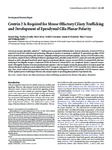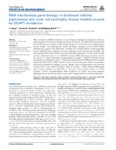|
|
Creator | Title | Description | Subject | Date |
| 1 |
 |
Frederick, Jeanne M. | Inhibitors of metalloendoprotease activity prevent K+-stimulated neurotransmitter release from the retina of Xenopus laevis. | Metalloendoprotease activity was identified in retinal homogenates using a synthetic fluorogenic metalloendoprotease substrate and specific metalloendoprotease inhibitors. The requirement of metalloendoprotease activity in neurotransmitter release was examined during the depolarization-induced relea... | Neuromuscular Junction; Neurotransmitter Agents; Membrane Fusion | 1984 |
| 2 |
 |
Creel, Donnell J.; Leventhal, Audie G. | Retinal projections in tyrosinase-negative albino cats | Retinal projections were examined in two tyrosinase-negative albino cats using autoradiographic techniques. Cats from this colony have pink eyes; their retinal pigment epithelium, ciliary body, and iris epithelium are completely devoid of melanin pigment. Test breeding for five generations indicates... | Cats; Albinism; Vision; Autoradiography; Retina | 1982-07 |
| 3 |
 |
Normann, Richard A. | Effects of GABA and related drugs on horizontal cells in the isolated turtle retina | The role of GABA in the outer plexiform layer of the turtle retina has been examined by intracellular recordings from L- and C-type horizontal cells in the isolated retina preparation. GABA (1-5 mM) slightly depolarized the L-type horizontal cells, reduced the amplitude of their photoresponses, and ... | Retina; Horizontal Cells; Synapse; Negative Feedback; GABA; Turtle | 1990 |
| 4 |
 |
Normann, Richard A.; Muller, Jay F.; Kolb, Helga | Synaptic inputs to physiologically defined turtle retinal ganglion cells | Two physiologically distinct, HRP-marked turtle retinal ganglion cells were examined for their morphology, GABAergic, glycinergic, and bipolar cell synaptic inputs, using electron-microscopic autoradiography and postembedding immunocytochemistry. One cell was a color-opponent, transient ON/OFF gangl... | Turtles; Neural Pathways; Synapes; Retinal Ganglion Cells | 1991 |
| 5 |
 |
Normann, Richard A.; Maynard, Edwin M. | Neuronal interactions improve cortical population coding of movement direction | Interactions among groups of neurons in primary motor cortex (MI) may convey information about motor behavior. We investigated the information carried by interactions in MI of macaque monkeys using a novel multielectrode array to record simultaneously from 12-16 neurons during an arm-reaching task. ... | Motor Cortex; Monkey; Population Coding; Movement | 1999 |
| 6 |
 |
Angelucci, Alessandra | Segregation and overlap of callosal and association neurons in frontal and parietal cortices of primates: a spectral and coherency analysis. | The spatial relations between selected classes of association and callosal neurons were studied in the frontal and parietal lobes of the macaque monkey using retrogradely transported fluorescent dyes. Fast blue and nuclear yellow were injected in the left frontal (areas 4 and 6) and right posterior ... | Macaca fascicularis; Parietal Lobe; Neurons | 1989 |
| 7 |
 |
Normann, Richard A.; Chandler, John P. | Effects of calcium ions on L-type horizontal cells in the isolated turtle retina | A technique by which the retina can be isolated from the turtle eye is described. Scanning electron microscopy revealed morphological variability between preparations and also between regions of the same one. Large areas were often totally free of any pigment epithelial cells, yet contained a high p... | Retina; Calcium; Horizontal Cell; Turtle | 1990 |
| 8 |
 |
Normann, Richard A. | Acute human brain responses to intracortical microelectrode arrays: challenges and future prospects | The emerging field of neuroprosthetics is focused on the development of new therapeutic interventions that will be able to restore some lost neural function by selective electrical stimulation or by harnessing activity recorded from populations of neurons. As more and more patients benefit from thes... | | 2014-01-01 |
| 9 |
 |
Baehr, Wolfgang | Cloning and molecular characterization of cGMP-gated ion channels from rod and cone photoreceptors of striped bass ( M. saxatilis ) retina | Vertebrate photoreceptors respond to light with changes in membrane conductance that reflect the activity of cyclic-nucleotide gated channels (CNG channels). The functional features of these channels differ in rods and cones; to understand the basis of these differences we cloned CNG channels from t... | Amino Acid Sequence; Computational Biology; Reverse Transcriptase Polymerase Chain Reaction | 2006 |
| 10 |
 |
Baehr, Wolfgang | Calcium-sensitive particulate guanylyl cyclase as a modulator of cAMP in olfactory receptor neurons | The second messengers cAMP and inositol-1,4,5-triphosphate have been implicated in olfaction in various species. The odorant-induced cGMP response was investigated using cilia preparations and olfactory primary cultures. Odorants cause a delayed and sustained elevation of cGMP. A component of this c... | Calcium-Binding Proteins; Nerve Tissue Proteins; Rats, Sprague-Dawley | 1998 |
| 11 |
 |
Frederick, Jeanne M. | Centrin 2 is required for mouse olfactory ciliary trafficking and development of ependymal cilia planar polarity | Centrins are ancient calmodulin-related Ca2-binding proteins associated with basal bodies. In lower eukaryotes, Centrin2 (CETN2) is required for basal body replication and positioning, although its function in mammals is undefined. We generated a germline CETN2 knock-out (KO) mouse presenting with s... | | 2014-01-01 |
| 12 |
 |
Frederick, Jeanne M. | Uncoordinated (UNC)119: Coordinating the trafficking of myristoylated proteins | The mechanism by which myristoylated proteins are targeted to specific subcellular membrane compartments is poorly understood. Two novel acyl-binding proteins, UNC119A and UNC119B, have been shown recently to function as chaperones/co-factors in the transport of myristoylated G protein a-subunits an... | | 2012-01-01 |
| 13 |
 |
Angelucci, Alessandra | Experimentally induced retinal projections to the ferret auditory thalamus: development of clustered eye-specific patterns in a novel target | We have examined the relative role of afferents and targets in pattern formation using a novel preparation, in which retinal projections in ferrets are induced to innervate the medial geniculate nucleus (MGN). We find that retinal projections to the MGN are arranged in scattered clusters. Clusters a... | Retina; Ferrets | 1997 |
| 14 |
 |
Normann, Richard A.; Branner, Almut | Long-term stimulation and recording with a penetrating microelectrode array in cat sciatic nerve | We studied the consequences of long-term implantation of a penetrating microelectrode array in peripheral nerve over the time course of 4-6 mo. Electrode arrays without lead wires were implanted to test the ability of different containment systems to protect the array and nerve during contractions o... | Cats; Microelectrodes; Prosthesis Implantation; Sciatic Nerve | 2004 |
| 15 |
 |
Angelucci, Alessandra | Role for nitric oxide in the development of the ferret retinogeniculate projection | The ferret retinogeniculate projection segregates into eye-specific layers during the first postnatal week and into ON/OFF sublaminae, which receive inputs from either on-center or off-center retinal ganglion cells, during the third and fourth postnatal weeks. The restriction of retinogeniculate axo... | Enzyme Inhibitors; Visual Pathways; Wheat Germ Agglutinin-Horseradish Peroxidase Conjugate | 1996 |
| 16 |
 |
Normann, Richard A.; Kolb, Helga | Neural organization of the retina of the turtle Mauremys caspica: a light microscope and Golgi study | The organization of the retina of the turtle species Mauremys caspica, found in fresh water ponds of Israel, has been examined by light microscopical techniques including examination of fresh wholemount retina, one micron blue-stained vertical sections and Golgi-stained material. The anatomical find... | Turtle Retina; Photoreceptors; Golgi Technique; Amarcine Cells | 1988 |
| 17 |
 |
Levine, Edward M. | Sonic hedgehog promotes rod photoreceptor differentiation in mammalian retinal cells in vitro. | The hedgehog gene family encodes secreted proteins important in many developmental patterning events in both vertebrates and invertebrates. In the Drosophila eye disk, hedgehog controls the progression of photoreceptor differentiation in the morphogenetic furrow. To investigate whether hedgehog prot... | Sonic hedgehog; Indian hedgehog; Desert hedgehog; Retina; Mitogenesis; Differentiation; Rod Photoreceptor | 1997-08-15 |
| 18 |
 |
Frederick, Jeanne M. | RNA interference gene therapy in dominant retinitis pigmentosa and cone-rod dystrophy mouse models caused by GCAP1 mutations | RNA interference (RNAi) knockdown is an efficacious therapeutic strategy for silencing genes causative for dominant retinal dystrophies. To test this, we used self-complementry (sc) AAV2/8 vector to develop an RNAi-based therapy in two dominant retinal degeneration mouse models. The allele-specific ... | | 2014-01-01 |
| 19 |
 |
Normann, Richard A. | Functional reorganization of primary visual cortex induced by electrical stimulation in the cat. | Compared to the high degree of plasticity observed in a juvenile, mature sensory cortices have long been held to be immutable but, recently, researchers have suggested some plasticity persists in the mature cortex. Cortical reorganization has particular saliency to the development of a cortically ba... | Cat; Electrophysiology; Phosphene; Plasticity; Receptive Field; Striate Cortex | 2005 |
| 20 |
 |
Jones, Bryan W. | Molecular phenotyping of retinal ganglion cells | Classifying all of the ganglion cells in the mammalian retina has long been a goal of anatomists, physiologists, and cell biologists. The rabbit retinal ganglion cell layer was phenotyped using intrinsic small molecule signals (aspartate, glutamate, glycine, glutamine, GABA, and taurine) and glutama... | Aspartic Acid/metabolism; Image Cytometry/methods | 2002 |
| 21 |
 |
Frederick, Jeanne M. | The prenyl-binding protein PrBP/δ: A chaperone participating in intracellular trafficking | Expressed ubiquitously, PrBP/d functions as chaperone/co-factor in the transport of a subset of prenylated proteins. PrBP/d features an immunoglobulin-like b-sandwich fold for lipid binding, and interacts with diverse partners. PrBP/d binds both C-terminal C15 and C20 prenyl side chains of phototran... | | 2012-01-01 |
| 22 |
 |
Normann, Richard A.; Maynard, Edwin M. | Neural interface for a cortical vision prosthesis | The development of a cortically based vision prosthesis has been hampered by a lack of basic experiments on phosphene psychophysics. This basic research has been hampered by the lack of a means to safely stimulate large numbers of cortical neurons. Recently, a number of laboratories have developed a... | Neuroprosthetics; Artificial Vision; Electrode Arrays; Multielectrode Recordings; Biocompatibility | 1999 |
| 23 |
 |
Angelucci, Alessandra; Lund, Jennifer S. | Circuits for local and global signal integration in primary visual cortex | Contrast-dependent changes in spatial summation and contextual modulation of primary visual cortex (V1) neuron responses to stimulation of their receptive field reveal long-distance integration of visual signals within V1, well beyond the classical receptive field (cRF) of single neurons. To identif... | Primary Visual Cortex; Extrastriate Cortex; Feed-back Connections; Lateral Connections; SUrround Modulation; Macaque | 2002-10-01 |
| 24 |
 |
Baehr, Wolfgang | Identification and light-dependent translocation of a cone-specific antigen, (Cone Arrestin) recognized by monoclonal antibody 7G6 | PURPOSE: To elucidate the antigen recognized by monoclonal antibody (mAb) 7G6, a widely used cone-specific marker. METHODS: 7G6 immunocytochemistry was performed on sections of human, primate, and bovine retina. The antigen was immunoprecipitated from human retinal lysates and purified with protein ... | Cones (Retina); Molecular Sequence Data; Phototransduction | 2003 |
| 25 |
 |
Baehr, Wolfgang | Characterization of the chicken GCAP gene array and analyses of GCAP1, GCAP2, and GC1 gene expression in normal and rd chicken pineal | PURPOSE: This study had three objectives: (1) to characterize the structures of the chicken GCAP1 and GCAP2 genes; (2) to determine if GCAP1, GCAP2, and GC1 genes are expressed in chicken pineal gland; (3) if GC1 is expressed in chicken pineal, to determine if the GC1 null mutation carried by the re... | Molecular Sequence Data; Promoter Regions (Genetics); Retinal Degeneration | 1999 |

























